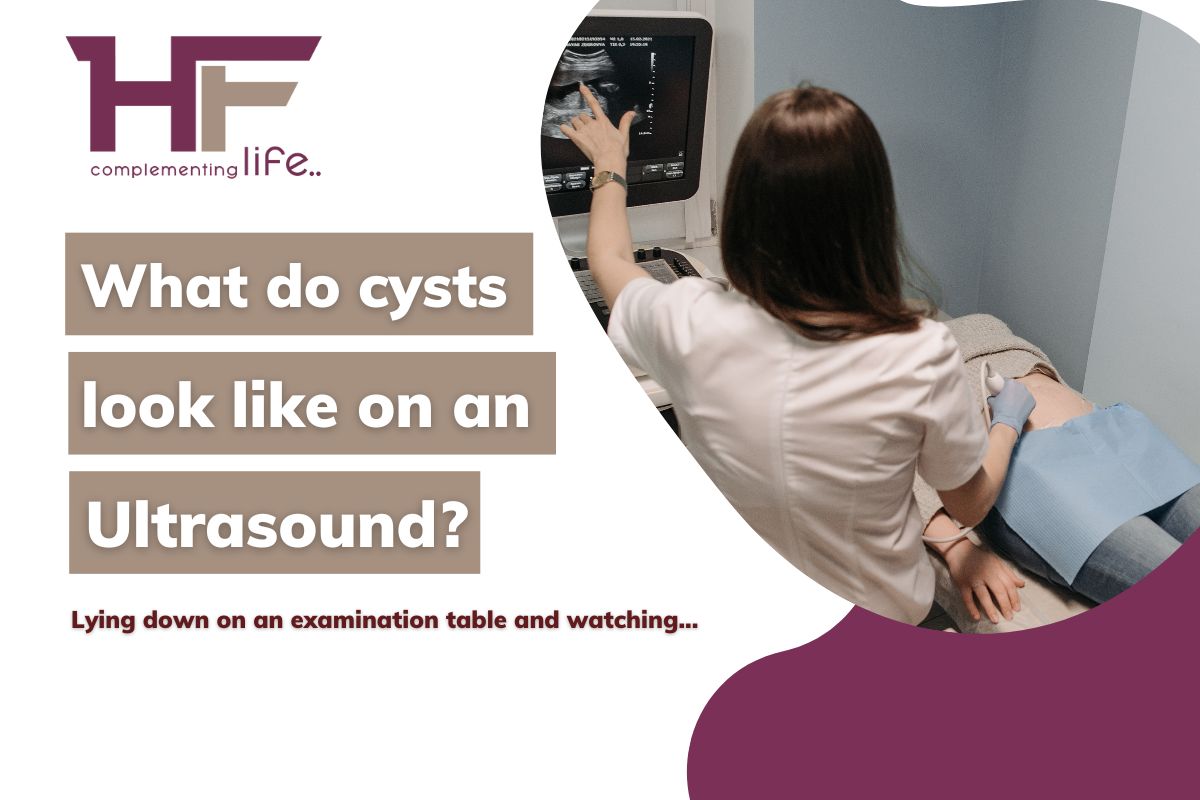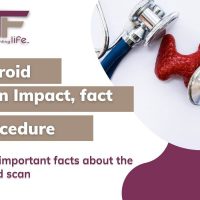What do cysts look like on an Ultrasound?
You are lying down on an examination table and watching the grey-painted ceiling. You know that something is bothering you, your health, for the past few days. But, you are not sure what it is!
Of course, your doctor, on hearing your symptoms like – Severe pelvic pain, frequent vomiting, fever, rapid breathing, & heaviness near the abdomen – must have predicted the potential cause.
She wanted confirmation and certainly why she asked for the diagnosis, namely, ultrasound.
You, on the other hand, in desperation to learn what it is, took the road of surfing and found the various causes. One among them is some pocket-like areas in your tissues that do not normally exist therein! Medical science calls these cysts.
While the sonographer in the lab inserts the wand-like instrument called transducer into your abdomen through the vagina, you lie down silent, taking deep breaths, as asked with determination not to move until instructed.
Perhaps you are keen to see if it is the cysts that are disrupting your normal life, and you do not want to miss even a bit of accuracy in the diagnosis by shaking or moving about! Yet again, you are scared of the instrument going inside your body. A state of dilemma you are in now!
The clock goes like – tick-tock; tick-tock! Silence wraps the room full of medical technologies, and you are on your task of hearing and feeling every tiny thing going on. At some time later, you also try to convince yourself by looking up that things are going to be okay, and the very next moment, you seek to divert your mind and focus on the white lights, having a beautiful wall holder.
Wait,
Did the sound waves just pass through a fluid-filled cyst and made a faint echo?
Did the radiologist say to the technician that it appears black on the display screen?
Well,
The ultrasound process is on, and the team of medical professionals at work fetches a colored image from the computer’s interpretation.
At the back of your mind, you keep thinking it is a cyst, but you want to be cent percent sure.
No doubt, if I was in your position, I would have done the same! At this moment, I would be eager to know what they actually look like in an ultrasound, right on the display!
Alas! I won’t be able to do so, and nor can you! So, how about discovering them even before going to the test? That is the only way to picture what the medical professionals are watching!
This article shall show – What do cysts look like on an ultrasound? It shall give you a complete note on the condition, its types, locations, sizes, shapes, and all that the radiologist and his team can see during the ultrasound.
CContents
Where are the cysts found?
These pocket-like areas can make their space anywhere in your body – Starting from the face to the genitals, scalp & brain, cardiovascular organs to the liver, and so forth.
But, their frequency of living tends to revolve mainly around –
- Skin,
- Breasts,
- Ovaries, &
- Kidneys.
Usually, the location depends upon the causes. The cysts that grow due to chronic inflammatory conditions are likely to form on your kidneys, liver, or nearby areas. Likewise, the cysts that result from a faulty organ within a developing embryo tend to reside in your ovaries.
On the other note, your symptoms, particularly pelvic pain and heaviness in the abdominal areas, suggest that the cysts may stay and live either inside your ovaries or on the outside layer.
Spot on! That’s what the team of medical caregivers is watching on the screen!
Multiple of them appear like colorful patches in the display – A big cluster at some point and another big scattered to a distance!
What may have actually caused this?
In reference to the above, we can also say that when the medical experts check the location of these bumps during the ultrasound, they also locate the underlying cause. They can be any of the following!
1. Considering the leading cause behind the formation of cysts in Indians today, ovulation can be the one! Do you know while the ovulation process is on, inside your body, one of the ovaries releases an egg from a small sac known as a follicle? That’s right. And when the follicle fails to release the egg, cysts pop up. Just like it may have happened in your case!
2. Sometimes, abnormal cell production in your ovaries stands to be the potential cause. Such excessive cell production culminates either from the egg cells or the ones covering the outer part of the ovaries. Always remember that these cysts have got nothing to do with the menstrual cycle and menopause!
3. Alas! There is also a possibility that you are suffering from pelvic inflammatory disease, or in short, PID. For instance, it can be a severe pelvic infection that has spread to the ovaries, simulating the birth of cysts.
4. Tell me, are you in an advanced stage of endometriosis? I mean, did your doctor say that the tissues, the one that normally grows on the inner lining of the uterus called endometrium now, grow outside it? It may be the reason for the formation of cysts! When the endometrial tissues get thick, it breaks down and bleeds alongside your periods. However, it is also when they fall into the trap of having no exit from the body. As a result, cavities take the stage and lead to cysts.
The Factors increasing the chance of ovarian cysts: Why was it you?
Now, you must be thinking that anyone with an ovary can actually have cysts, but why was it you out of so many?!
Undoubtedly, certain factors enhance the possibility of cysts, and one among them can be your answer to the above question! They are –
Your Age –
Yes. Your age, sometimes, or actually most of the time, acts as the disease-stimulating factor! Studies say that all individuals who are yet to have menopause are vulnerable to ovarian cysts. The most probable time is your reproductive age, especially at the beginning of it. In other words, adolescent age, between 15 to 19 years, is prone to the growth of ovarian cysts.
But, you need to note that the age factor may vary depending on the type of cysts. For instance, some cysts that medical science calls Dermoid cysts are more common in women who fall under the age group of 20 to 40 years. [ Please See: We shall talk about Dermoid cysts in detail in the next column.]
So, what is your age? Does it stand as a plausible factor behind your health condition?
Your Pregnancy Status –
Do you have the good news? Well, I mean, are you pregnant? If so, the good news itself acts as the possible reason behind the ovarian cysts you have today! Besides, they wish to remain throughout your pregnancy.
Normally, when you are not pregnant, the follicle sac shrinks into the hormone-producing cells in order to support the rest of the menstrual cycle, whereas, during the time of pregnancy, it shrinks to support the growth of your baby. Cysts take place when this normal course of functioning stands altered. In simple words, cysts appear when the follicle does not shrink and instead continues to grow. It is because they do not have space to break down; your baby is growing!
Your History or Your Family History of Cysts –
If you already had cysts before, you are likely to have them a second time. Is that the plausible factor you are looking for?
If not,
Your family history may be the cause! Yes. Just like the dangerous ovarian cancer, ovarian cysts can also run in families. In fact, a genetic predisposition to ovarian cancer can also trigger ovarian cysts.
So, ask out and confirm within your family – Did any of them have ovarian cysts or cancer in their lifetime? Do they know anyone from the ancestry who had ovarian cysts or cancers?
Your Medical Condition At Present –
In a similar fashion, you are prone to ovarian cysts if you are already going through certain medical conditions, like –
1) Hormonal problems,
2) Ovulation problems,
3) Polycystic Ovary Syndrome or PCOS,
4) Obesity, &
5) Hyperthyroidism.
Herein, the medications you are taking can also be the cause. Cysts grow when you take medications, like –
1) Clomiphene to help get rid of ovulation problems,
2) Oral contraceptive packages for birth control,
and 3) Letrozole used for treating cancers and particularly breast cancer! Recall once again! Are you consuming any of them as a part of the cure for your present medical condition?
Which type of cysts are they?
Ovarian cysts, in following the causes and additional factors increasing the possibility, may differ from person to person.
Doctors usually predict them from the symptoms themselves!
And,
Your symptoms say that there are quite a few possibilities.
At the initial level, ovarian cysts are broadly categorized into two types – Functional & Others. While the former is more common, the latter is rare and occurs in response to many things other than menstruation.
Your cysts can fall into either category. Are you keen to know what type exactly they are?
Well, the cysts that pop up on the monitor after getting the electric signals from the sound waves can be any of the following!
When it falls under the category of functional cysts, i.e., the ovarian cysts that involves menstrual functions and are not disease-related, occurring as a result of normal ovulation, you may have –
Follicular Cysts
Follicular Cysts are those arising from the condition where your follicles in the ovaries cannot release an egg during ovulation. Perhaps, they are the most usual cysts of all times & women! They have thin walls bearing flattened or cuboidal granulosa cells that enjoy an increased amount of follicular fluids and remain in the absence of an oocyte!
Medical science also regards them as Graafian Follicle Cysts. The ones that can grow up to 7cm in diameter, & generally disappear on their own in 1 to 3 months!
If you are a fertile woman, these cysts may even form every month during your menstrual cycle and live without giving any symptoms.
Corpus Luteum Cysts
Another possibility is the Corpus Luteum Cysts that originate from the follicular cysts themselves. When the follicular cysts do not rupture, fluids collect and fill up the hormone-producing group of cells therein called corpus luteum, we call them Corpus Luteum Cysts.
These cysts, similar to the former ones, can disappear on their own within a few weeks or so. However, they can grow as large as 4 inches across your ovary and twist it, thereby causing enormous pain & bleeding.
They, too, do not throw any usual symptoms unless growing big. In this regard, it stands salient for you to know that when they grow big and spontaneous bleeding occurs in them, they are called Haemorrhagic Corpus Luteum.
Even though not always but if you are a pregnant woman or are expecting a child, these kinds of cysts have more possibilities to come up!
After these functional cysts, also called simple cysts that do not require any specific treatment, it’s time to discover the other category. The ones that occur when you are having a medical condition or disease and subsequently require proper treatment for going obsolete! They are –
Teratomas
Also known as Dermoid Cysts, Teratomas refer to those cysts that grow when any tissues collect under the skin. Somewhat resembling an enclosed sac below the skin surface, they appear in the picture and may comprise hairs, oil, nerves, teeth, or sweat glands. Yes, teratomas hold the capacity to bear cells that cover all kinds of tissues in the human body. Even the brain tissues!
The main cause behind such abnormal growth is that the skin layer does not grow together as they should. Do you know that they can exist in both ovaries in about 10 to 15 percent of the cases? That’s true! These ovarian germ cell tumors are not uncommon and may exist even from the time of birth and catch the human eye only at a diagnosis.
Although they are benign in nature, you must keep in mind that they may fall heavy on your health condition shortly. It is because they can affect your body by leading to conditions like ovarian torsion. This means that they can make your ovaries turn out of shape. In fact, they can also create a rupture in the ovary.
So, if this turn out to be the one your radiologist is checking, be prepared to go through an immediate treatment in the next couple of days. But, I must say, there is nothing to panic about!
Cystadenomas
The Cysts that emerge on the surface of the ovary are called cystadenomas. They are multilocular cysts, having a smooth surface, both inner & outer, and contain papillary projections in the lining. Usually, they are large in size. Well, sometimes even as large as 10 cm in diameter!
Do you know that cystadenomas comprise nearly 60 percent of ovarian tumor cases? That is right!
And,
The ovarian cystadenomas are rare & generally asymptomatic, containing watery or thick fluids.
If you are in your 30s to 60s, this can be the possible type you have! Apart from the people of your age group, they may appear in younger women in their 20s (Or vice versa).
Endometriomas –
Endometriomas refer to those cysts that contain endometrial tissues, the same that you bleed every month during your menstrual cycle. They originate mainly from endometriosis, in its third or fourth stage. To be more precise – when you have a health condition like endometriosis where the endometrial tissues grow outside the uterus, the endometrial cells pile up as a menstrual fluid-filled sac or an endometrioma.
Well, an endometrioma encompasses a thick tar-like fluid that is brownish in shade; and that is why it is sometimes called the chocolate cyst. The one mostly growing in women between 25 to 40 years!
Disclaimer! Medical science considers them the most serious threat to the reproductive potential of a woman. Endometriomas are rare in nature & can even turn cancerous at some point in time.
A Few Facts: What shape do they have?
Herein, the above-stated possibilities in the type are likely to not resemble each other. Depending on which type of ovarian cysts you have, the shape shall vary from one to another and appear precisely visible in an ultrasound.
You can ask the medical professionals if you wish to – What shape is it?
- Ovarian cysts are typically fluid-filled, having no solid growth. So, on the ultrasound, they shall possibly resemble some bubbles lying in a clustered or scattered form!
- They appear round or oval and have smooth, thin walls.
- It is important for you to understand that no internal flow of fluids shall come up only on the Color Doppler imaging.
- Ovarian cysts are round because the fluids present inside experience a kind of molecular attraction to the center, making the surface act as a stretched membrane.
- The medical expert can simply quote it as ‘almond’ indeed!
A Few Facts: How large are they?
By now, you already know that cysts vary in size. But, how large can they?
- Well, the average diameter in the case of large cysts stands at 4 cm or 10 inches. It can even be larger than that. And when small, they can be around 1 cm in diameter or even less than that.
- If they are functional cysts, studies reveal that they are plausibly 2 to 3 inches in diameter. In other words, they are 1.5 to 5 cm in size.
- These cysts, being mostly harmless in nature, often grows slowly. Yes, they generally progress at a rate of 0.07 Inches in a year. However, they can, at times, grow at a drastic rate over a week or a few months. No doubt, with all its aggression!
So, the possibilities remain that you may have a large one!
Can they turn risky?
Even when you have a large cyst, there is nothing to fear. They are not life-threatening and can go away with minor surgery.
Survey records have shown in 80 percent of the cases, ovarian cysts are likely to disappear on their own and do not require surgery. Even if you need surgery, the chance of further complications is only 1 percent. On the contrary, if left untreated, they can turn harmful and even cancerous at times!
Some of the complications of removing ovarian cysts via surgical methods are –
1. Excessive Bleeding,
2. Infections,
3. Blood Clots,
4. Damages to some other organs,
5. Need for the removal of the ovaries, or one of them, &
6. Infertility.
But, do not consider any of the side effects of the surgery as a complication. The usual side effects that can arrive after the surgical removal of cysts are –
1. A small amount of bleeding,
2. Discomfort in your lower tummy,
3. Fatigue or tiredness,
4. Pain in your shoulders due to the anesthetic injections, and so forth.
Of course, you shall inform your doctor, but they are not some complications. The use of a Minimally-Invasive surgical method may eliminate both risks and side effects from the picture, particularly the former!
Sure, they are not cancers and are just cysts!
You can’t be sure before the test, of course. However, cases of ovarian cysts appearing malignant are relatively rare. Various Studies say that the circumstance for a cyst to emerge cancerous situates at around 1 in 78 cases in India. In this regard, Pathologist cysts, unlike functional ones, are more prone to malignancy.
I know what you are thinking of right now. Ovarian cysts and ovarian cancers do share common symptoms. The ones you are having!
And,
It is impossible to say whether it is cancer or not just from the symptoms.
But since you are in your reproductive phase, the chance is low. Ovarian cysts can turn cancerous when you already had your menopause, around the age of 50 to 60 years. Today, ovarian cancer lay mostly detected among women within the age group of 60 to 64 years.
Despite so, the lifetime risk therein is also relatively low!
What are the suitable treatments for it?
Now that you are positive about the pocket-like areas being benign and harmless, you certainly do not want them to create some other complications by leaving them untreated!
After your ultrasound brings out accurate data, your gynecologist shall look for the best suitable treatment depending on it.
Once the size of the cyst is visible in the ultrasound imaging, the doctor shall know whether a surgical procedure stands requisite or shall medications suffice. She may also opt for a non-invasive method to shrink them down or suggest you have a watchful wait-and-see technique.
No doubt, you can pursue the watchful waiting when the cysts are small in size and related to the normal ovulation cycle.
But,
In recent times, laparoscopy and laparotomy are the two most popular methods for treating ovarian cysts.
Your doctor may prescribe a birth control pill to prevent the cysts from occurring by causing temporary menopause and corollary-stopping ovulation. They cannot shrink down the cysts but can sigh relief from the development of further cysts.
Last words:
That’s all for now. I hope the article shall be beneficial for you to fill up your knowledge gaps before going to an ultrasound for a condition like ovarian cysts. Also, the moment you encounter any of the symptoms of an ovarian cyst!
For more queries about cysts, you can drop your question directly at our website, www.healthfinder.in.
We, HealthFinder, are nothing but an online healthcare marketplace that can connect you to the best gynaecologist in Chandigarh or the entire of Tricity. We partner with doctors, hospitals, clinics, and diagnostic centers to give you access to a wide and complete pool of healthcare services, from the facility of cabs or ambulances to pick-up drop you at the healthcare centers, online appointments with doctors, to pre-booking diagnostic tests.
So, whenever you need any of these services, just know that we are just a message away!










Comments